No start: Solenoid clicking, "charging system fault".. which to fix first?
#21
Tech Contributor

Member Since: Dec 1999
Location: Anthony TX
Posts: 32,736
Received 2,180 Likes
on
1,583 Posts
CI 6,7,8,9,11 Vet
St. Jude Donor '08

The car will time out with the doors open.. IF,, you shut the door after it times out, it will wake back up. Basically, if you do anything to change the current draw after it times out, it will wake back up.
If you disconnect the BATT terminal on the back of the alternator (big red wire under the black rubber boot on the back of the alternator) and place the DC Amp meter betwen the red wire and the alternator terminal, you should see ZERO current draw. If you see any current draw, one or more of the diodes in the alternator are defective.
GROUNDS: ENGINE Ground G-106 (passenger side engine block) or Chassis ground G-104/108 (Small negative wire coming off the negative battery terminal and attached to the frame)
G-106
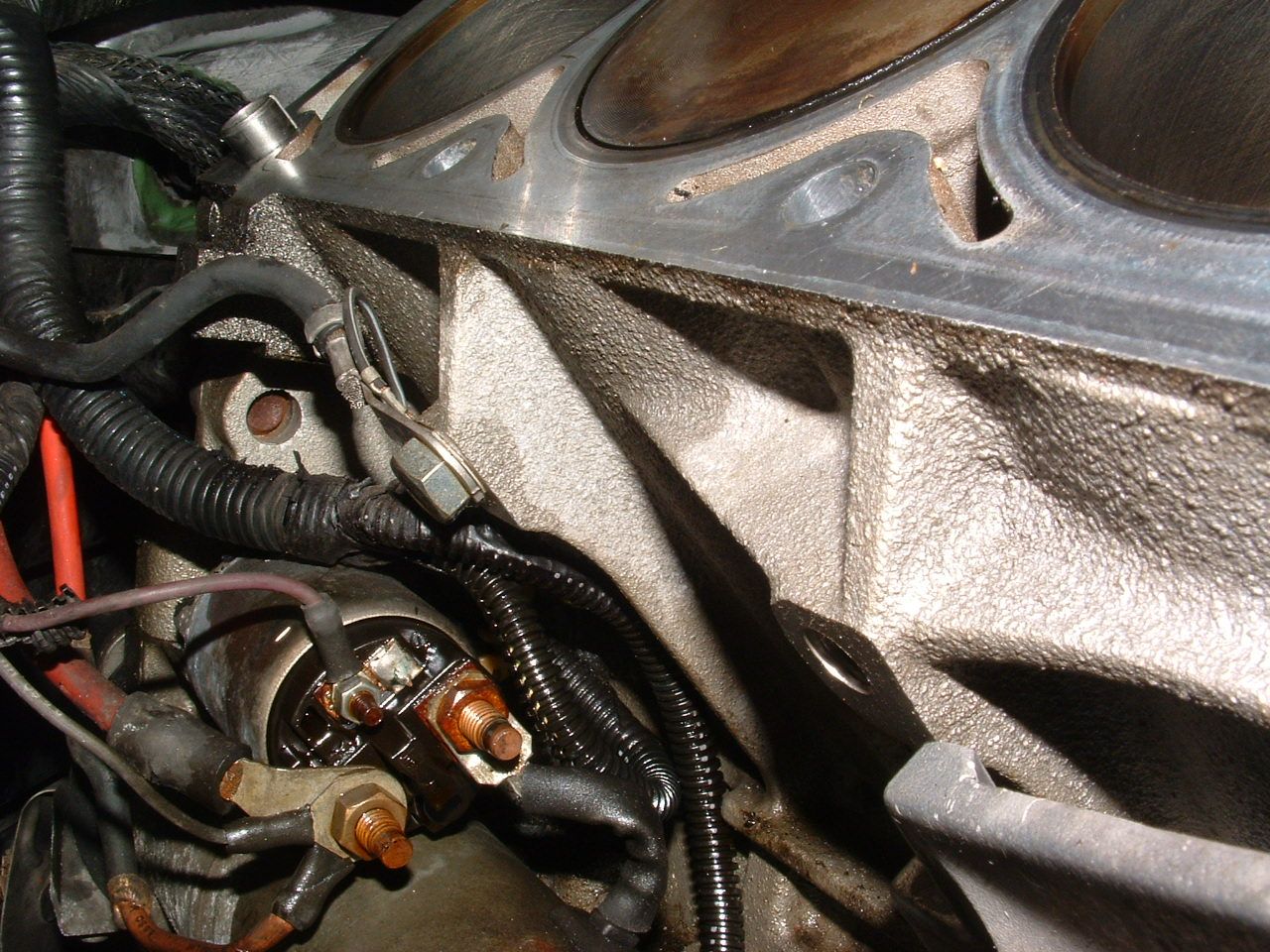
G-104/108
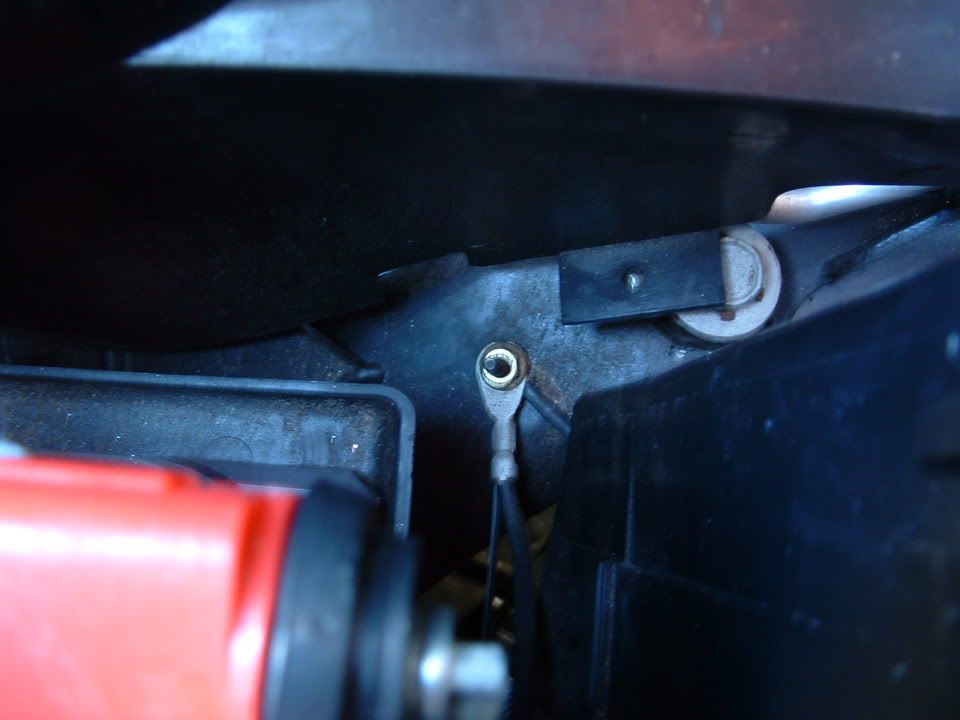
Try this procedure:
The engine compartment fuse box has a B+ terminal on the end of the box. Your box will have TWO wires. One is the 12VDC feed from the battery and the other is a feed through wire that goes to the Passenger Compartment Fuse box.

Remove the neg battery wire (for safety) Remove both of the wires on the B+ terminal. Find a nut and bolt to connect the two red wires together. This completely ISOLATES the engine compartment fuse box and ALL the loads off of it. If you still have excessive current draw, its coming from a load in the passengers fuse box. After you make all your connections and everything is safe, reconnect the NEG battery terminal.
Some things you can just UN PLUG. Like the LRCM, RDCM, and Seat connector. You can take them completely out of the loop.
Bill
If you disconnect the BATT terminal on the back of the alternator (big red wire under the black rubber boot on the back of the alternator) and place the DC Amp meter betwen the red wire and the alternator terminal, you should see ZERO current draw. If you see any current draw, one or more of the diodes in the alternator are defective.
GROUNDS: ENGINE Ground G-106 (passenger side engine block) or Chassis ground G-104/108 (Small negative wire coming off the negative battery terminal and attached to the frame)
G-106

G-104/108

Try this procedure:
The engine compartment fuse box has a B+ terminal on the end of the box. Your box will have TWO wires. One is the 12VDC feed from the battery and the other is a feed through wire that goes to the Passenger Compartment Fuse box.

Remove the neg battery wire (for safety) Remove both of the wires on the B+ terminal. Find a nut and bolt to connect the two red wires together. This completely ISOLATES the engine compartment fuse box and ALL the loads off of it. If you still have excessive current draw, its coming from a load in the passengers fuse box. After you make all your connections and everything is safe, reconnect the NEG battery terminal.

Some things you can just UN PLUG. Like the LRCM, RDCM, and Seat connector. You can take them completely out of the loop.
Bill
#22
Bill, can you verify that something is wrong with my digital multi meter. When I connect the battery like normal, I see a spark (recorded on video if you're interested--it isn't huge though) and hear relays powering up, especially the headlights. But there is no spark when I connect my digital multi meter (which I have admittedly abused) in series between the negative battery terminal and the negative battery terminal cable.
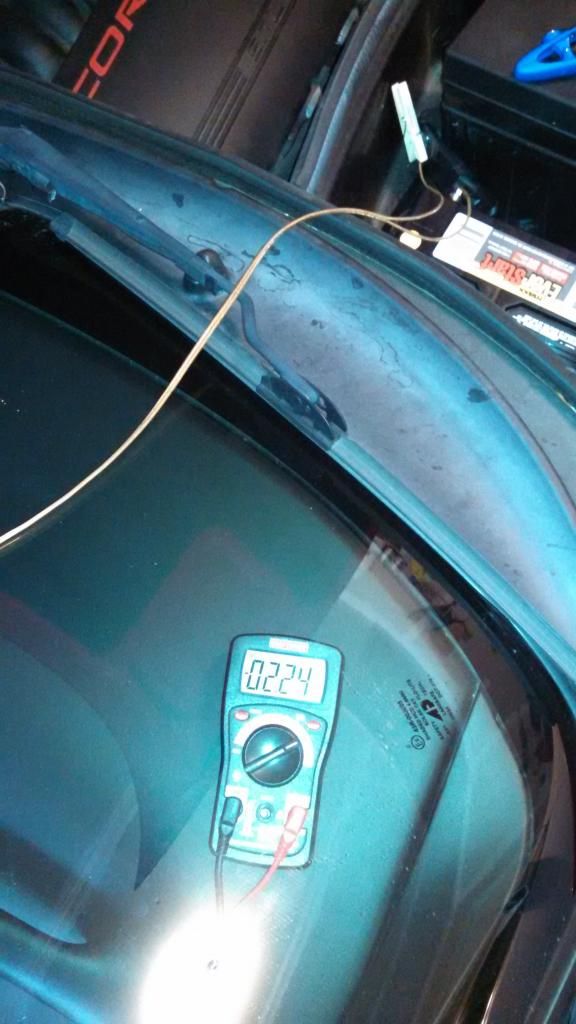

The meter does show 12.2 V on the new battery, and it does show 2.2A (give or take) when connected in series to the negative terminal. But nothing in the car gets powered (lights when opening door, loud headlight motor relays, etc) , and the reported current doesn't change over time. When I cracked the case of the DMM I noticed several corroded connectors, and the 250mA 200V hair fuse was blown. 10A is listed as un-fused... so I'm hoping it's still useful for hunting big draws. It seems to report voltage correctly, at least.
If it sparks to the battery terminal wire, shouldn't it spark to the DMM probes when it's set to 10A? Shouldn't the car power up as if connected to the battery?
... I'm glad my meter was cheap, but I'm wondering if it's worth getting a better one!
#23
Race Director


Member Since: Apr 2007
Location: South Western Ontario
Posts: 11,061
Received 845 Likes
on
721 Posts

Does the reading just stay the same all the time connected or not? If it does, then the meter is dead on that setting. You are using the 10A setting and moving the lead to the 10A terminal?
#24
Had the thought this morning that I really need a nut (and washer maybe) to make a reliable & proper connection on the battery cable. It might simply be only that.. Sadly there's no ACE in my area so i can't go buy just 1 3/8-16 nut. (Got some really strange retail things going on here. No BoA either.)... If so, here's another "list for posterity."
What you need to measure parasitic current:
- Digital multi meter with 10A (or higher) DC current setting. (Treat it nicely, it can break)
- If you don't have someone who can sit by the battery and read out numbers for you: 10' or so of thick speaker wire, stripped 1/2 to 3/4 inch at each end. It's nice to know which side is which (if no stripe, look for a bumpy side) but most DMMs can simply report negative current if you screw up. Edit: Don't use thin wire--especially speaker wire--because it will get hot. The worse your problem, the worse this will be. Even 18 gauge (typical speaker wire) seems risky--audio amps send higher voltage AC which has less current, so in that case it's OK. But here bigger is safer.
- side terminal bolt. The kind that fits in the battery cable is at wally world, but any 3/8-16 bolt could work. Just don't insert it into the battery too far, seems like 1/2 inch is the max safe depth.
- 3/8-16 nut for the cable's bolt, to complete the circuit
|
Seem right?
Last edited by 150kWh; 09-22-2014 at 11:32 PM. Reason: Don't use thin wire.
#25
Good connection, same 2.23A on the (seemingly broken) DMM. ... For those following closely, you can make out the new addition as of today, a nut on the terminal wire, in the photo (even though the focus & arrow is on something else). You can buy loose nuts at Lowes, hooray. (Picked up a stainless bolt&nut for the B+ fuse bypass, as well.) Also, I learned I could insert the speaker wire a bit into the battery terminal hole before screwing in my extra bolt, to guarantee a good connection there.. there's some room there.
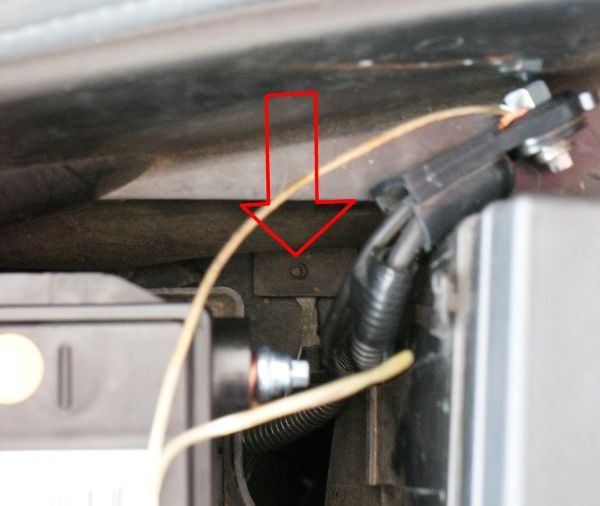
This is what one normally sees as G104/108, right? .. it's inside the battery subdivision. Maybe my 2002 is different from the photos Bill posted.
No one has explicitly answered, but I'm running on this assumption: When all this is working right, it's supposed to load the relays, boot the computer, turn on the interior courtesy lights, etc. ... Maybe, for whatever reason, my DMM when set to 10A mode is stuck, and the 2.23A number is meaningless. Mine keeps showing constant 2.23A, when connected in series to the battery. No drop off. No initial 8A.
So... sayonara DMM--for this task, at least. It has a thermocouple setting, a voltage measurement which I guess is still working, and it's autoranging meter which is nice for an idiot like me. But.. Dang. I'll get another one.

This is what one normally sees as G104/108, right? .. it's inside the battery subdivision. Maybe my 2002 is different from the photos Bill posted.
No one has explicitly answered, but I'm running on this assumption: When all this is working right, it's supposed to load the relays, boot the computer, turn on the interior courtesy lights, etc. ... Maybe, for whatever reason, my DMM when set to 10A mode is stuck, and the 2.23A number is meaningless. Mine keeps showing constant 2.23A, when connected in series to the battery. No drop off. No initial 8A.
So... sayonara DMM--for this task, at least. It has a thermocouple setting, a voltage measurement which I guess is still working, and it's autoranging meter which is nice for an idiot like me. But.. Dang. I'll get another one.

Last edited by 150kWh; 09-20-2014 at 04:06 PM. Reason: courtesy lights, not headlights which might fry a 10A DMM setting
#26
This is off topic slightly, but at least it's electrical.
How to find the under hood light connector: towards the front/passenger side under the hood

what mine looked like, scraping out a lot of corrosion:
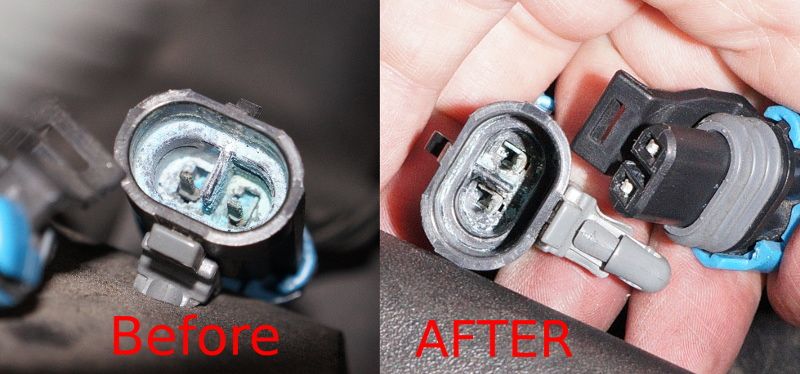
I applied quite a bit of dielectric grease (didn't fill up the connector, but.. that might not be a poor idea) but it didn't make a connection unless I compressed the connectors in passed the click a bit. Not sure if that's a result of the male or female end of the connector... but I was able to use a couple tiny zip ties to squeeze it together.
One minor conundrum SOLVED. Now I can diagnose my current drain. ... at night. ...as long as the battery & the aux fuse aren't the reasons I'm having problems. Again.
How to find the under hood light connector: towards the front/passenger side under the hood

what mine looked like, scraping out a lot of corrosion:

I applied quite a bit of dielectric grease (didn't fill up the connector, but.. that might not be a poor idea) but it didn't make a connection unless I compressed the connectors in passed the click a bit. Not sure if that's a result of the male or female end of the connector... but I was able to use a couple tiny zip ties to squeeze it together.
One minor conundrum SOLVED. Now I can diagnose my current drain. ... at night. ...as long as the battery & the aux fuse aren't the reasons I'm having problems. Again.

#27
Race Director


Member Since: Apr 2007
Location: South Western Ontario
Posts: 11,061
Received 845 Likes
on
721 Posts

OK, if it the meter changes when you connect then it may be OK. Next you are going to start pulling some of the fuses or circuit breakers for the stuff most likely to cause a problem and see if you can find the drain?
#28
Tech Contributor

Member Since: Dec 1999
Location: Anthony TX
Posts: 32,736
Received 2,180 Likes
on
1,583 Posts
CI 6,7,8,9,11 Vet
St. Jude Donor '08

Volt Meters have a very high internal resistance rated as OHMs Per Volt. So,,, you will not see the current arc when you connect the meter.. On the current scale, you are only passing a low current so, it really wont or shouldnt power anything over 10 amps. If you try to power a high current circuit, you will blow the meters internal protection fuse.
#29
Volt Meters have a very high internal resistance rated as OHMs Per Volt. So,,, you will not see the current arc when you connect the meter.. On the current scale, you are only passing a low current so, it really wont or shouldnt power anything over 10 amps. If you try to power a high current circuit, you will blow the meters internal protection fuse.
When you initially connect the AMP meter in the circuit, the current draw will be high. Some where around 8 amps. As the BCM determines that the car is secure, it will start dropping off loads and go into the SECURITY MODE and Sleep Mode. As it drops off loads you will see the battery current drop down from 8 amps to around 2-3 amps them in the milliamp range.
If there is a unwanted load, it could take up to 10-15 min for the current reading to settle out as low as it will go. The target reading will be 15-20 milliamperes. As you can see in the next photo, my 02 ZO6 draws .02 or 20 milliamperes.
If there is a unwanted load, it could take up to 10-15 min for the current reading to settle out as low as it will go. The target reading will be 15-20 milliamperes. As you can see in the next photo, my 02 ZO6 draws .02 or 20 milliamperes.
I already ordered a replacement DMM, arrives tomorrow, so I can do a side-by-side comparision. I'm guessing I fried the 10A ammeter setting on the current one by being dumb with the old battery. (It is not fused on 10A setting.) If not I was being dumb to jump to buy a new one. Dumb either way

#30
The new meter works much better... I guess the old one is now a dedicated thermocouple display, since it reads voltage. ... Adventures in digital multi-meters 
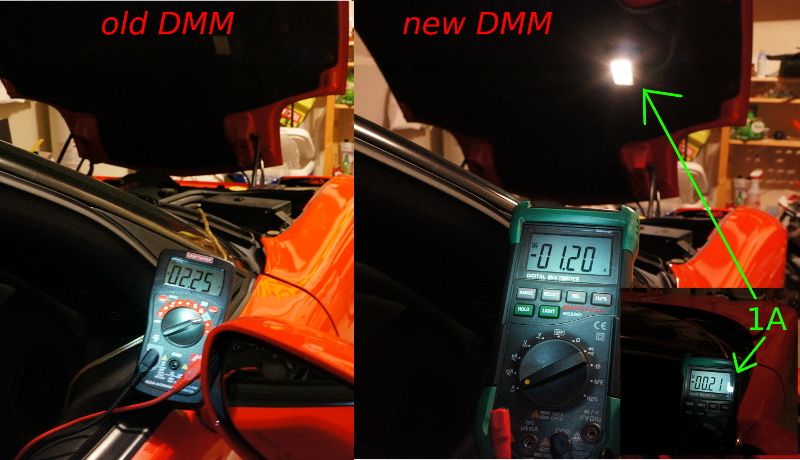
The inset lower right shows the reading immediately after closing the hood, before it goes into sleep mode. (The door wasn't open.)
For posterity, here's the behavior over time, when connected in series at the negative battery terminal:
I'm happy to see such low sleep draws! Happy.. and suspicious. Maybe the previous battery was just bad, wouldn't last 3 years, but I find it curious that so many people have parasitic current issues. I suppose that fixing the under hood light could have helped, but.. maybe I rubbed up against a ground or something? But whatever it is wasn't going on today.
There are two things I'm suspecting right now:
..Also, though this exercise, I noticed indications of prior work in the passenger foot well fuse box. The bendy plastic shield was kinda hanging down & not attached well, the kick board panel doesn't have velcro (there are two empty circular slide-slot molded attachment point, looks like some velcro pads were removed). ..And... there's what appears to be a piece of black duct tape wrapped on one wire into the fuse box. (Maybe power for something like a radar detector?) I didn't pull at it or look carefully, yet. Also, minor thing, an thin exposed bolt seems to stick straight out under there. I brushed against it by accident and it set off the car alarm, super annoying. But I figure it's just grounded and it's normal. Looks like something is supposed to be covering it, though.
Anyway.. I'll keep an eye out and reserve the right to post again if I find something. If I find a red herring, I'll try to post in case it helps someone else later.
Thanks kindly for the continued help


The inset lower right shows the reading immediately after closing the hood, before it goes into sleep mode. (The door wasn't open.)
For posterity, here's the behavior over time, when connected in series at the negative battery terminal:
Code:
DOOR SHUT when first connected 1 sec 2.X? A 5-6 sec 1.23 7-60 sec 0.08 4 min 0.01 OPEN THE DOOR, reset the clock 0 min 5.9A Dash gauges + Interior lights 2 min 5.75A (stays nearly constant) 10 min 2.06A Interior lights only (no gauges) 15 min 0.8A no lights 0.5 0.16 16 min 0.11 30 min 0.04
There are two things I'm suspecting right now:
- Yesterday I removed the fuse for the power antenna, thinking I could still listen to CDs. But it seems like something's wrong with the sound, like static of bad reception even when I play a CD. I'll replace the fuse soon, but I'm curious if something with the radio or amp got fried under the low voltage. If I see draw there I'll post.
- Reverse bypass solenoid. I need to replace it--it seems to work intermittently. Maybe it's on a good day right now. If it gets stuck partially open, could it be a drain?
..Also, though this exercise, I noticed indications of prior work in the passenger foot well fuse box. The bendy plastic shield was kinda hanging down & not attached well, the kick board panel doesn't have velcro (there are two empty circular slide-slot molded attachment point, looks like some velcro pads were removed). ..And... there's what appears to be a piece of black duct tape wrapped on one wire into the fuse box. (Maybe power for something like a radar detector?) I didn't pull at it or look carefully, yet. Also, minor thing, an thin exposed bolt seems to stick straight out under there. I brushed against it by accident and it set off the car alarm, super annoying. But I figure it's just grounded and it's normal. Looks like something is supposed to be covering it, though.
Anyway.. I'll keep an eye out and reserve the right to post again if I find something. If I find a red herring, I'll try to post in case it helps someone else later.
Thanks kindly for the continued help
Last edited by 150kWh; 09-22-2014 at 11:34 PM. Reason: under hood light, not under dash



